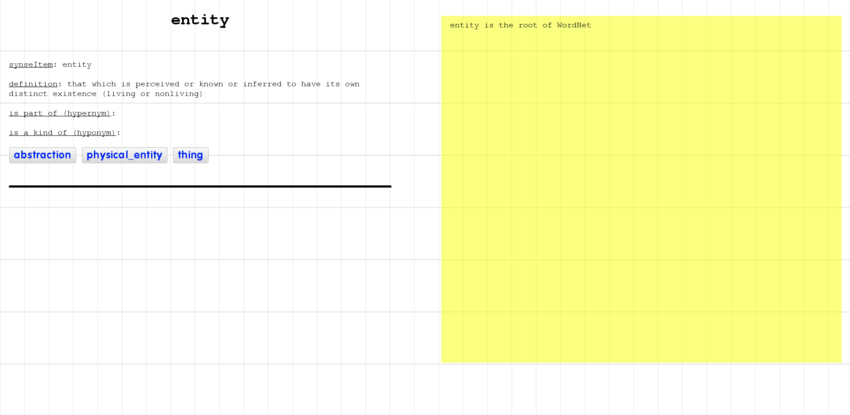User:Manetta/wordnet/: Difference between revisions
No edit summary |
|||
| Line 1: | Line 1: | ||
<div style="width: | <div style="width:100%;max-width:850px;"> | ||
__NOTOC__ | |||
=WordNet= | =WordNet= | ||
[[File:Mb-wordnet-tour-interface-root.png| | [[File:Mb-wordnet-tour-interface-root.png|850px]] | ||
==*== | |||
WordNet is a lexical dataset and a primary resource in the field of Knowlegde Discovery in Data processes (also known as the field of data-mining and big-data). WordNet is built with word-'synsets' (where a word could have multiple entries according to multiple meanings), which are related to eachother by various relations, like: word-type, categorie or synonyms. This dataset has been developed since 1985, and is basically a norm in the field, used during training processes of data-mining algorithms. Although the focus on word-synsets is an attempt to create a nuanced model of a human language, the dataset is still a model, and will always be 'imperfect'. | |||
As written language is regarded as 'data' today, data-mining techniques 'read' written text to return 'information'. It's a constructive truth instead, and datasets as WordNet are functioning as the 'norm' of such truths. | |||
Looking closer into WordNet is an attempt to reflect on methods in which meaningless data is transformed into semantic data (in this case according to WordNet's norms). How can this normalizing resource be a design tool? And where would we like to apply it onto? And would it be possible to reflect on the question why there is still the aim to built such universal systems? | |||
==so far== | |||
[[User:Manetta/wordnet/wordnetwords | * WordNet words (about) ]]<br> | [[User:Manetta/wordnet/wordnetwords | * WordNet words (about) ]]<br> | ||
[[User:Manetta/prototyping/conversational-interfaces-WordNet-tour | #prototype: WordNet tour (part of conversational interfaces)]]<br> | [[User:Manetta/prototyping/conversational-interfaces-WordNet-tour | #prototype: WordNet tour (part of conversational interfaces)]]<br> | ||
[[User:Manetta/i-could-have-written-that/wordnet-case-studies | * WordNet in the wild]]<br> | |||
==notes== | |||
no | |||
ne | |||
Revision as of 15:18, 19 November 2015
WordNet
*
WordNet is a lexical dataset and a primary resource in the field of Knowlegde Discovery in Data processes (also known as the field of data-mining and big-data). WordNet is built with word-'synsets' (where a word could have multiple entries according to multiple meanings), which are related to eachother by various relations, like: word-type, categorie or synonyms. This dataset has been developed since 1985, and is basically a norm in the field, used during training processes of data-mining algorithms. Although the focus on word-synsets is an attempt to create a nuanced model of a human language, the dataset is still a model, and will always be 'imperfect'.
As written language is regarded as 'data' today, data-mining techniques 'read' written text to return 'information'. It's a constructive truth instead, and datasets as WordNet are functioning as the 'norm' of such truths.
Looking closer into WordNet is an attempt to reflect on methods in which meaningless data is transformed into semantic data (in this case according to WordNet's norms). How can this normalizing resource be a design tool? And where would we like to apply it onto? And would it be possible to reflect on the question why there is still the aim to built such universal systems?
so far
* WordNet words (about)
#prototype: WordNet tour (part of conversational interfaces)
* WordNet in the wild
notes
no ne



